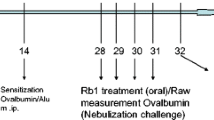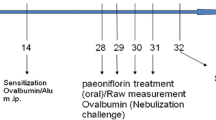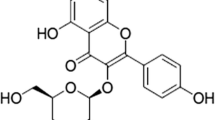Abstract
This study was conducted to explore the anti-asthma effects of synthetic salidroside on cytokines and airway inflammation of asthma induced by diisocyanate (TDI) in mice. The experiment was carried out 60 female BALB/C mice which were randomly assigned to six experimental groups: control, vehicle, model, dexamethasone (2 mg/kg), and salidroside (24 and 48 mg/kg). After the experiment, histological studies were evaluated by the hematoxylin and eosin staining, the bronchoalveolar lavage fluid (BALF) and blood were collected from the animals, and the composition of the induced inflammatory cells, and the concentrations of certain cytokines (IL-4, INF-γ) were evaluated. GATA3 and T-bet mRNAs were evaluated by QPCR. Our study demonstrated that salidroside inhibited TDI-induced increases in eosinophil count; IL-4 and INF-γ were recovered. Histological studies demonstrated that salidroside substantially inhibited TDI-induced eosinophilia in lung tissue. Salidroside can improve T-bet mRNA and reduce GATA3 mRNA in lung. These findings suggest that salidroside may effectively ameliorate the progression of asthma and could be used as a therapy for patients with allergic asthma by regulating GATA3/T-bet balance.





Similar content being viewed by others
References
Gautrin, D., A.J. Newman-Taylor, H. Nordman, and J.L. Malo. 2003. Controversies in epidemiology of occupational asthma. European Respiratory Journal 22: 551–559.
Johnson, V.J., J.M. Matheson, and M.I. Luster. 2004. Animal models for diisocyanate asthma: Answers for lingering questions. Current Opinion in Allergy and Clinical Immunology 4: 105–110.
Scheerens, H., T.L. Buckley, T.L. Muis, et al. 1999. Long-term topical exposure to toluene diisocyanate in mice leads to antibody production and in vivo airway hyperresponsiveness three hours after intranasal challenge. American Journal of Respiratory and Critical Care Medicine 159: 1074–1080.
Matheson, J.M., V.J. Johnson, and M.I. Luster. 2005. Immune mediators in a murine model for occupational asthma: Studies with toluene diisocyanate. Toxicological Sciences 84: 99–109.
Song, Jiafu, Hai** Zhao, et al. 2013. Mechanism of E-cadherin redistribution in bronchial airway epithelial cells in a TDI-induced asthma model. Toxicology Letters 220: 8–14.
Bu-Chun Zhang et al. 2012. Salidroside decreases atherosclerotic plaque formation in low-density lipoprotein receptor-deficient mice. Evidence-Based Complementary and Alternative Medicine Article ID 607508, 5 pages.
Lee, Meeyoung, et al. 2009. Anti-inflammatory and anti-asthmatic effects of resveratrol, a polyphenolic stilbene, in a mouse model of allergic asthma. International Immunopharmacology 9: 418–424.
Djukanovic, R., W.R. Roche, J.W. Wilson, C.R. Beasley, O.P. Twentyman, R.H. Howarth, et al. 1990. Mucosal inflammation in asthma. American Review of Respiratory Disease 142: 434–457.
Świerczyńska-Machura, D., et al. 2012. Immunological determinants in a murine model of toluene diisocyanate-induced asthma. International Journal of Occupational Medicine and Environmental Health 25(4): 492–498.
DuanW, Chan J.H., C.H. Wong, et al. 2004. Anti inflammatory effects of mitogen-activated protein kinase inhibitor U0126 in an asthma mouse model. Journal of Immunology 172: 7053–7059.
Gelfand, E.W. 2002. Pro: Mice are good model of human airway disease. American Journal of Respiratory and Critical Care Medicine 166(1): 5–6.
Ebino, K., H. Ueda, H. Kawakatsu, Y. Shutoh, T. Kosaka, E. Nagayoshi, et al. 2001. Isolated airway exposure to toluene diisocyanate results in skin sensitization. Toxicology Letters 121: 79–85.
Elsner, J., and A. Kapp. 1999. Regulation and modulation of eosinophil effector functions. Allergy 54: 15–26.
Chunhua Ma, et al. 2013. Anti-asthmatic effects of baicalin in a mouse model of allergic asthma. Phytotherapy Research.
Gavett, S.H., D.J. O’Hearn, X. Li, S.K. Huang, F.D. Finkelman, et al. 1995. Interleukin 12 inhibits antigen-induced airway hyperresponsiveness, inflammation, and Th2 cytokine expression in mice. Journal of Experimental Medicine 182: 1527–1536.
Wong, C.K., C.Y. Ho, et al. 2001. Proinflammatory cytokines (IL-17, IL-6, IL-18 and IL-12) and the cytokines (IFN-γ, IL-4, IL-10 and IL-13) in patients with allergic asthma. Clinical and Experimental Immunology 125: 177–183.
Acknowledgments
This work was supported by National twelve five major drug discovery project (2011ZX09102-002-01).
Author information
Authors and Affiliations
Corresponding author
Rights and permissions
About this article
Cite this article
Wang, J., **ao, L., Zhu, L. et al. The Effect of Synthetic Salidroside on Cytokines and Airway Inflammation of Asthma Induced by Diisocyanate (TDI) in Mice by Regulating GATA3/T-bet. Inflammation 38, 697–704 (2015). https://doi.org/10.1007/s10753-014-9979-x
Published:
Issue Date:
DOI: https://doi.org/10.1007/s10753-014-9979-x




